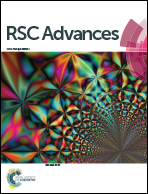Glucan particles loaded with a NIRF agent for imaging monocytes/macrophages recruitment in a mouse model of rheumatoid arthritis†
Abstract
Glucan Particles (GPs) are hollow pseudo-microspheres (average diameter 3–5 μm) obtained from common baker's yeast Saccharomyces cerevisiae, in which mannan, lipids and proteins are removed through a process of chemical extraction. GPs shell is mostly made of 1,3-β-D-glucan that allows for their prompt in vivo uptake by immune system cells. In this work, the inner cavity of the particles has been loaded with two amphiphilic fluorescent dyes (based on cyanine for in vivo imaging purposes and rhodamine for ex vivo microscopy experiments) through a sudden change in solvent polarity that allowed the entrapment of the molecules as microemulsion. The ability of fluorescent GPs to label immune cells in vivo and report on their recruitment in inflamed sites has been successfully demonstrated in a mouse model of rheumatoid arthritis (CIA) by NIRF imaging. Besides providing the visualization of the mononuclear cell infiltration in the lesion, the fluorescent signal well correlated with the clinical score associated with the disease. Very interestingly, the signal detected in lesions with the same clinical score allowed the assessment of the time evolution (progression or remission) of the pathology.


 Please wait while we load your content...
Please wait while we load your content...